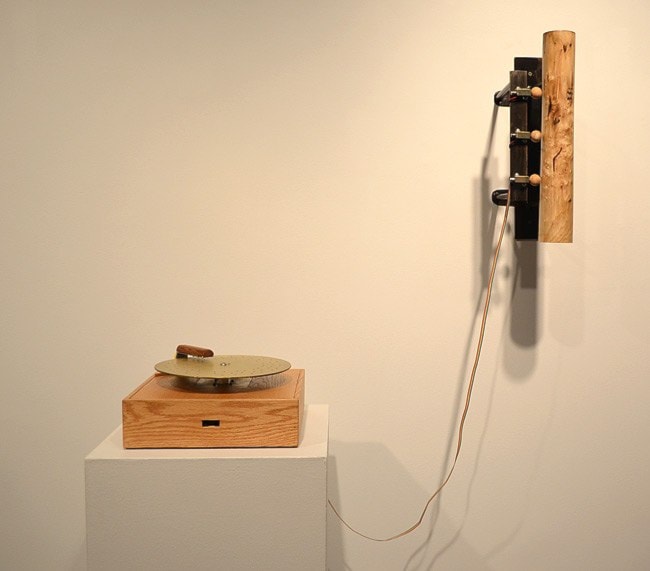Meg Walker
Special to the News
On a walk on her parents’ farmland in rural Ontario, Guelph artist Annie Dunning came across a log that had been thoroughly pecked by a yellow-bellied sapsucker. The idea of “decoding” the marks, playing with possible translations of the patterns, took the interdisciplinary artist into the studio.
Animals and birds are always adapting to the effects of human presence, so Dunning flipped the equation to explore how humans might respond to the “message” that woodpecker introduced. Her curiosity led to seven artworks, now on display as the show “Sapsucker Sounds” at the ODD Gallery in Dawson City.
Dunning’s first approach was sculptural. She took the log and made several bronze casts from it, and used them to form the shimmering sculpture “Constellation.” A light shines through the beak-holes, turning them into possible stars.
Next, she carved the log down and hollowed it out to make a sounding-board for a work called “Record.” For this piece, Dunning perforated a flat metal disc with the woodpecker’s spacing and placement of holes in the log. When a visitor walks by, the disc “translates” those holes into electric signals that make wooden balls tap against the now-hollow log. Voila: a recreated “playback” of the woodpecker’s tapping appears.
The shape and colour of “Record” makes a tongue-in-cheek reference to the Voyager’s Golden Record, made by Carl Sagan and his team and sent out to space in 1977. Humans have perhaps put more resources into sending signals out (to space, to other animal species) than into receiving communication. In short, we might learn more about the non-human world by listening - by learning the languages of other species.
The emphasis on listening comes through in “Sapsucker Sounds” when a visitor triggers “Record,” and then a few seconds later, the companion work “Sign” repeats the sound. This call-and-response happens every time, but loud, sharp rat-a-tat-tat still makes most people jump.
Dunning has been thinking about human-nature relationships for ages. In 2010, she exhibited “Foolproof Four,” a show named after the four mushrooms that most people can identify (and eat) without accidentally poisoning themselves. For this project Dunning imagined superhero versions for the morel, shaggy mane, puffball and sulphur shelf mushrooms.
She has also created sound art by working with pigeons. For her 2007 work “Air Time,” Dunning spent time on Salt Spring Island, B.C., with Timothy Hume, who happens to care for about 300 homing pigeons. Part of her interest in pigeons is that they’re the oldest domesticated creature apart from dogs.
“They were his pets, and he knew the pedigree of each one and their abilities and which ones were good at what,” Dunning recalls. “I had made all these tiny lightweight flutes out of things like bits of bamboo and gourds and desiccated orange peel. So we mounted these flutes onto their tail feathers and then as we released them and they flew, the air would pass over the aperture of the flute and they made this sound.”
Where another artist might turn to books or music for inspiration, Dunning says she looks to environmental science when she is hungry for new information. “Right now I’m doing a residency at the School of Environmental Sciences at the University of Guelph, so I have really great access to some pretty diverse and bizarre projects,” she smiles.
In particular, she’s been working with a scientist who studies soil. “He collects core samples of soil and they’re in a plastic tube,” she explains. “One of the instruments he uses is a 3-D X-ray, it’s like a CAT scan of the sample, so they can analyze air space compared to the density of it. So he helped me take a 3D scan of a snail shell that I’m looking at for a new project that I’m working on, imagining that small structure as an amphitheatre in miniature.
“So usually it’s one particular detail about the creature or its relationship to humans that catches my attention, and then I start finding different ways to look at that idea. In the case of Sapsucker Sounds it was the woodpecker using the metal object to possibly increase its territorial range.”
“Sapsucker Sounds” is an elegant human translation of marks made by a bird in conversation, or maybe even a bird just looking for lunch. The show runs at the ODD Gallery until December 19.
Meg Walker is a writer and visual artist based in Dawson City.
